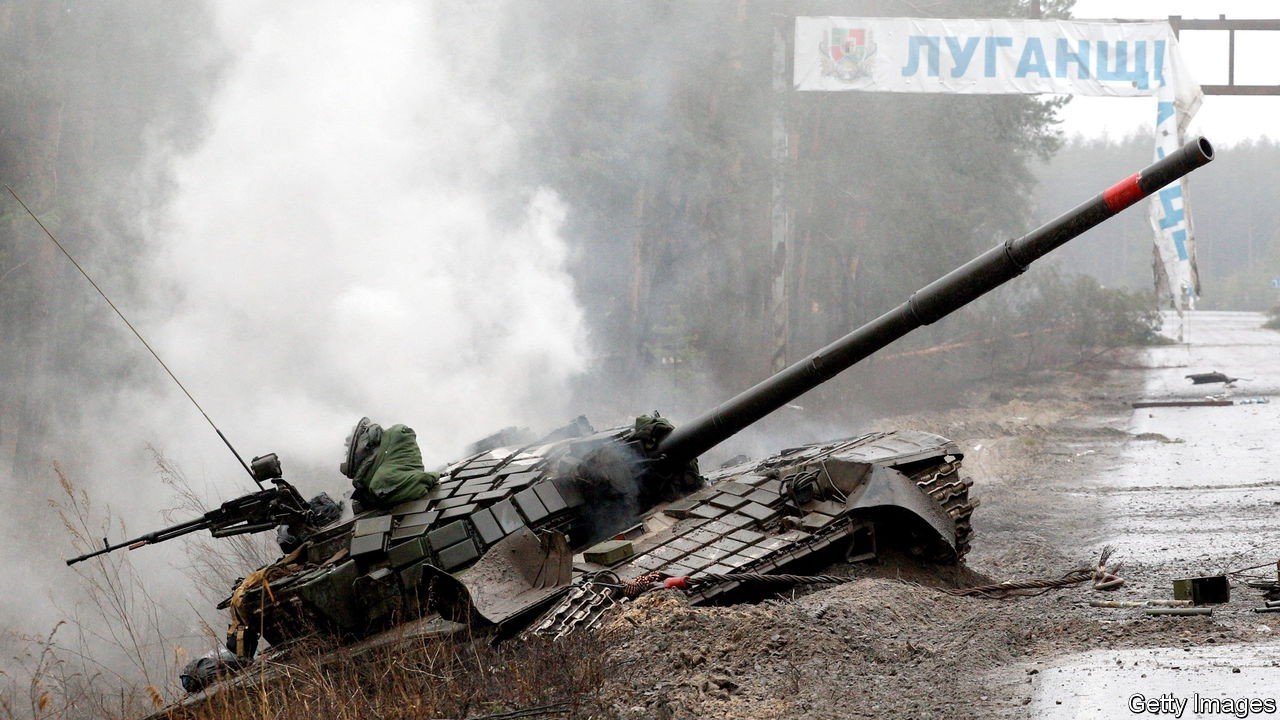WHEN SOVIET-LED forces invaded Czechoslovakia in 1968, it was a straightforward affair. The invaders met little resistance, the country’s leader was whisked off to Moscow on day two and the West “just swallowed it”, notes Sergey Radchenko, a historian. “What we have today in Ukraine is playing out very differently.”
The bulk of Russian forces are now 25km from the centre of Kyiv, the capital, and will probably encircle it in the coming days. Russian forces have also broken through Ukrainian lines in the south, driving west to Odessa, a major port, and north to the centre of the country, where they could cut off Ukrainian forces in eastern Ukraine. Kharkiv, which repelled attacks over the weekend, faced heavy shelling on Monday.
The Russian war machine is nevertheless struggling. Things are very different from 1968. But its performance is also “worse [than] in Georgia in 2008”, says Konrad Muzyka, a defence analyst. That war led to sweeping reforms to the armed forces, but perhaps not sweeping enough. Images from Ukraine show mangled clumps of Russian armour. A video from the alleged aftermath of an ambush on one convoy near Sumy, a north-eastern city, on Sunday, shows the loss of at least a dozen armoured vehicles, including two tanks, and a self-propelled howitzer. The question is whether these troubles are temporary or indicate a deeper rot that Ukraine can exploit.
Russia’s biggest problem appears to be logistics. A Western official says that Russia has particular problems with engineering units. Ukraine has blown up many bridges, and Russia has been unable to get bridging units through congested roads. Russian tanks and other vehicles lie abandoned on the roadside, either broken-down or out of fuel, suggesting supply lines are overstretched, and support units are unable to keep up. Marooned units are prime targets for ambushes. Ukrainian forces have no shortage of arms with which to strike them—in recent days, Denmark, Luxembourg and Finland became the latest European countries to say they would supply thousands of anti-tank missiles.
Nor has Russia secured the skies. Western officials thought that Russian missiles would wipe out Ukraine’s air defences—a network of radars and surface-to-air missiles—in the first hours of a war. In fact, the strikes were lighter than expected, possibly to conserve low stocks of precision munitions. Perhaps as a result, Russia has not made much use of its warplanes so far, though recent footage appears to show Su-34 bombers over Kharkiv and in the south of Ukraine.
The absence of air superiority has two knock-on effects. One is that soldiers lack proper fixed-wing air support—a historic weakness for Russia because of poor co-ordination between ground troops and air forces, says Guy Plopsky, an expert on the country’s air power. The other is that, because Russia is not sweeping the skies with fighter jets, Ukraine can keep more planes up—something helped by Russia’s sparing use of missiles, which means it is hitting only a few points on airfields, rather than cratering them completely. Ukraine is using its Turkish-made TB2 drones to conduct deadly strikes on unsuspecting Russian forces, who seem to have no idea what is above them. Few experts thought these drones would be usable four days into a war.
All of this points to deeper tactical shortcomings. In modern war different elements, including infantry, armour, artillery, air defence, engineering units and electronic warfare, are supposed to work together, each compensating for the other’s weaknesses. A tank, for instance, provides firepower for the infantry that travel with it; in turn, the infantry can dismount and hunt down anti-tank platoons. Russia is making a hash of this. In some cases, its tactics verge on the suicidal. A video reportedly taken in Bucha, a town north-west of Kyiv, shows a Russian armoured vehicle broadcasting propaganda, instructing civilians to remain calm. A man wielding a rocket-propelled grenade strolls up to the vehicle and calmly destroys it.
One reason for these blunders may be the scale of the Russian deployment. During its previous invasion of Ukraine in 2014-15, Russia sent no more than a dozen or so battalion tactical groups (BTGs) of 1,000-odd troops. This time it has sent well over 100. The result is “diluted BTGs”, as one American armour officer puts it. The intelligence units that would normally pick up signals of a TB2 loitering overhead and the artillery forces that would soften up Ukrainian defenders, as they did in 2015, may not be available in sufficient numbers to deploy into every BTG. “So now you’re leavening your best ingredients into a much larger loaf,” says the officer.
There are signs of poor morale in some units. Video footage shows at least one tank column hurriedly reversing after being confronted by unarmed civilians. Dima Adamsky, an expert on Russia’s armed forces at Reichman University in Israel, says he is surprised by the high numbers of young conscripts. They may be confused as to whether their Ukrainian opponents are brothers bound in “spiritual, human and civilisational ties”, as Vladimir Putin, Russia’s president, put it in an essay published last summer, or instruments of drug-addled Nazis, as he thundered recently. In Berdyansk, a port city that fell to Russia on Sunday, local residents openly protested against the Rosgvardia (national guard) troops on their streets.
Some Western officials and military experts conclude that Russia’s army is a paper tiger. “This isn’t a good army executing a bad plan…or out-of-context tactics,” says BA Friedman, a military analyst and reserve officer in the US Marine Corps. “It’s a bad army!” Others are more cautious. They say that Russian tactics may adapt in the days and weeks ahead, and that the country has mass on its side. Russia is yet to deploy a quarter of the forces on Ukraine’s border, according to American officials. One column, its southern end 27km from Kyiv’s centre, stretches over another 27km of road, according to satellite imagery. American officials also say that the Kremlin has sent fighters from the Wagner Group, a Kremlin-linked mercenary outfit, to Ukraine.
Russia has so far worked much harder to avoid civilian casualties than in its air campaign in Syria and than was expected at the start of the conflict, says Mr Adamsky. But the war may be entering an “uglier stage”, he warns. That is evident in Kharkiv. Rockets and cluster munitions have begun targeting residential areas, causing widespread damage to entire blocks of flats. Images show corpses littering the street. The appearance of Su-34 bombers suggests that the city may soon be struck from the air. Mr Putin’s gamble on a quick war has failed—now he appears set on a grim one.
Source: Economist



